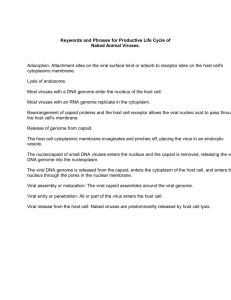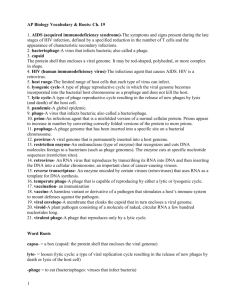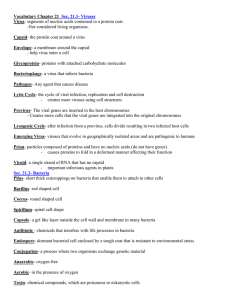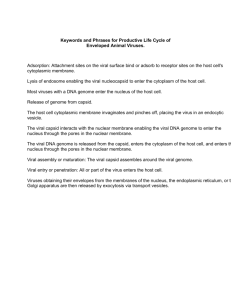محاضرة ثالثة
advertisement
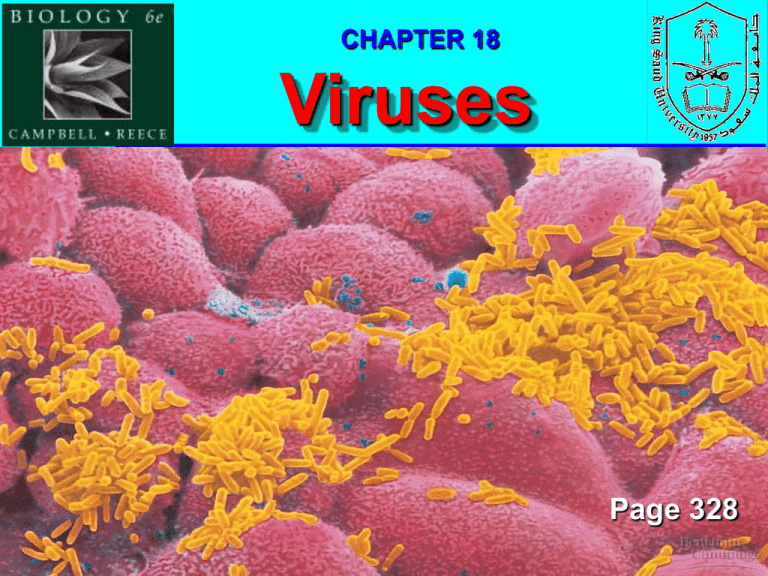
CHAPTER 18 Viruses Page 328 1 1- Viruses are much smaller than bacteria 2- Virus is about 20nm in diameter 3- Viruses are not cells 4- A virus is a genome حامض نووىenclosed in a protective coat غطاء واقى Fig. 18.1, Page 329 2 Virus is a genome enclosed in a protective coat Genome (DNA/RNA) Protein coat (capsid) 3 Fig. 18.2a & b, Page 330 Viral Capsid and Envelope A- Capsid الجدار الفيروسى • A protein shell that encloses the viral genome. • It is rode-shaped, helical, polyhedral or more complex. • Capsomeres: Are the protein units that form capsid. Capsomeres (proteins) Capsid Membranous envelop (viral envelope) Sometimes further rapped يُغَلَّفin a membranous envelope (Viral envelope ) الغالف الفيروسى, eg. Influenza virus. 4 Page 329, 330 B- Envelop الغطاء الفيروسى • Some viruses have viral envelopes, membranes cloaking their capsids. • These envelopes are derived from the membrane of the host cell. Fig. 18.2c, Page 330 5 Viral Genome: (Hereditary material )المادة الوراثية Viral genomes may consist of: - double-stranded DNA (dsDNA), - single-stranded DNA (ssDNA), - double-stranded RNA (dsRNA), - single-stranded RNA (ssRNA). depending on the specific type of virus. The viral genome is usually organized as a single linear or circular molecule of nucleic acid. The smallest viruses have only four genes, while the largest have several hundred. 6 Fig. 18.1, Page 328 Key Characters Viruses - DNA enclosed in a protein coat (sometimes, membranous envelop also) - Can be crystallised يتبلور - Each type of virus infects a limited range of host cells (host range )مدى اإلصابة - They lack يفتقدenzymes for metabolism - Have no ribosomes for making their own proteins - Reproduced only within a living host cell (obligate parasitism )تطفل إجبارى. Most viruses of eukaryotes attack specific tissues. eg. Human cold viruses infect only the cells lining the upper respiratory tract, and AIDS virus binds only to certain white blood cells (Immune system). 7 Virus-Reproduction within a living host cell Living Cell obligate parasitism تطفل إجبارى 1-Inters the cell and releases its genome 2- Replicates using host nucleotides and enzymes Viral RNA 3- Produce a new capsid units using host cell resources. 4- The new viral DNA and proteins assemble to form new viruses Page 331 (Fig. 18.3) Capsid Proteins 8 • A viral infection begins when the genome of the virus enters the host cell. • Once inside, the viral genome commandeers its host, reprogramming the cell to copy viral nucleic acid and manufacture proteins from the viral genome. • The nucleic acid molecules and capsomeres then self-assemble into viral particles and exit the cell. 9 Fig. 18.3, Page 331 • Viruses with an outer envelope use the envelope to enter the host cell. • – Glycoproteins on the envelope bind to specific receptors on the host’s membrane. – The envelope fuses with the host’s membrane, transporting the capsid and viral genome inside. – The viral genome duplicates and directs the host’s protein synthesis machinery to synthesize capsomeres with free ribosomes and glycoproteins with bound ribosomes. – After the capsid and viral genome selfassemble, they bud from the host cell covered with an envelope derived from the host’s plasma membrane, including viral glycoproteins. These enveloped viruses do not necessarily kill the host cell. Fig. 18.6, Page 334 10 • Human Immunodeficiency Virus (HIV), the virus that causes AIDS (Acquired Immuno-Deficiency Syndrome) is a retrovirus. The viral particle includes: 1) 2) 3) an envelope with glycoproteins, a capsid containing two identical RNA strands as its genome Two copies of reverse transcriptase. 11 Fig. 18.7a, Page 336 Bacteria infecting Viruses • Viruses that infect bacteria, are called bacteriophages or phages. • It has a 20-sided capsid-head that encloses their DNA and protein tail piece that attaches the phage to the host and injects the phage DNA inside. • Phages reproduce by Lytic Cycle ( )دورة تحـللية مميتــــةand/or Lysogenic cycle ( )دورة غير تحـللية. Fig. 18.2d Page 330 12 Bacteriophages (on E. coli) Phages reproductive cycles within bacteria: Virus Bacteria 1)- lytic cycle ( )الدورة التحـللية, The phage reproductive cycle results in the death of the host. – In the last stage, the bacterium lyses (breaks open) and releases the phages produced within the cell to infect others. • Virulent phages فيروسات قاتلةreproduce only by a lytic cycle. 13 Phage T4 (virulent viruses) فيروس مميت Fig. 18.4, Page 332 14 2)- lysogenic cycle ()الدورة غير التحـللية Phage lambda ()ג The phage genome replicates without destroying the host cell. • Temperate phages, like phage lambda ()ג, may use both lytic and lysogenic cycles. Temperate virus فـيــروس غير مميت • Within the host, the virus’ circular DNA engages in either the lytic or lysogenic cycle. • During a lytic cycle, the viral gene immediately turn the host cell into a virus-producing factory, and the cell soon lyses and releases its viral products. 15 2)- Lysogenic cycle ()الدورة غير التحـللية Unit 3 16 Fig. 18.5, Page 333 Phage T4 Many tail fibre Phage lambda ()ג Only 1 tail fibre (virulent viruses) Temperate virus فيروس مميت فيروس غير مميت أحيانا lytic cycle ()الدورة التحـللية Lysogenic cycle ()الدورة غير التحـللية & lytic cycle ()الدورة التحـللية 17


